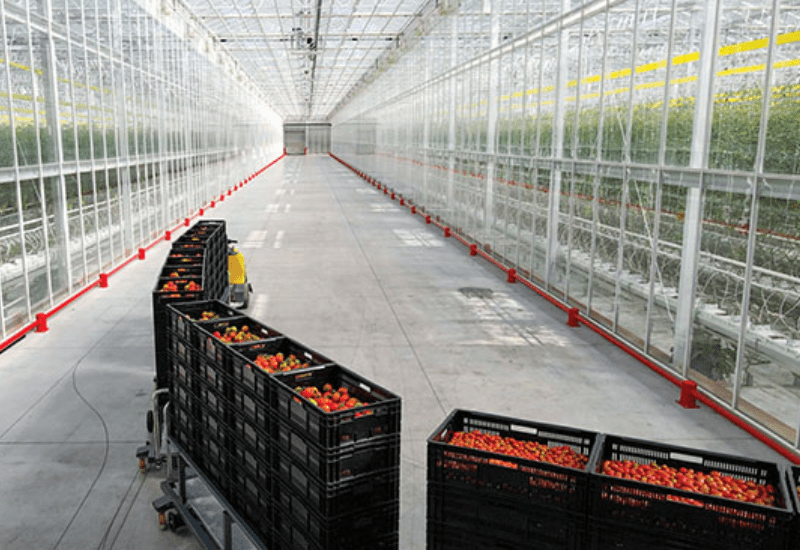
Relying on vertical integration for success
Red Sun Farms stands as one of North America’s largest, fully vertically integrated high-tech greenhouse growing operations. With complete ownership and control of the entire process, from seed selection to retail delivery, the company ensures year-round supply of top-quality produce.
The company’s genesis is the result of a merger that started in 2002. A dozen years earlier, Jim DiMenna had founded JD Marketing, and after finding success, partnered with another marketer and formed Jem D International.
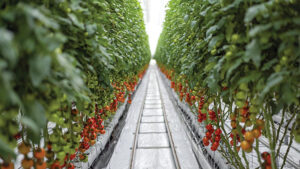
“In 2008, we were approached by Agricola el Rosal in Mexico, who brought the possibility to produce greenhouse tomatoes, peppers and cucumbers year-round, while maintaining ownership of all our farms,” DiMenna said. “In the spirit of collaboration, it was decided to rebrand and we created Red Sun Farms 15 years ago.”
AN EVOLUTION
DiMenna’s experience in the produce industry dates back to when he was 10 years old, selling vegetables from a wagon in his neighborhood, and he’s been going strong ever since.
From its humble beginnings with just over 160 acres in Kingsville, Ontario, Red Sun Farms has experienced remarkable growth with greenhouses across Mexico, Canada and the U.S. Today, Red Sun Farms owns a total of 800 acres, with supply partnerships representing an additional 200 acres.

“It’s a big selling point for our group that we’re vertically integrated,” DiMenna said. “We control every step in the process from seed selection, propagation, cultivation, packing, warehousing and shipping. We maintain ownership of every link in the supply chain. This method ensures continuity of supply, consistency and quality in every box. This distinction makes Red Sun Farms unique and the supplier of choice for our retail, food service and wholesale partners.”
Through the years, the business philosophy at Red Sun Farms has pretty much stayed the same as when DiMenna first started delivering the best product, at the best price, with the best service.
The Red Sun Farms corporate values of accountability, collaboration, trust and innovation are evident from seed to plate. This foundation of values allows the team to meet the growing demands of customers, ensuring that the consumer experience is the best in the industry all year long.
This strategy has supported growth of 5% to 10% annually, year over year, and DiMenna is confident that this trajectory of growth will continue for the business.
WIDE CUSTOMER BASE
Red Sun Farms supplies retail, food service and wholesale customers in the U.S., Canada and Mexico, with the goal of exceeding its partners expectations.
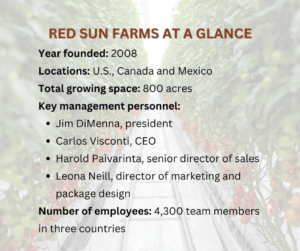
“Retailers evaluate their supply partners with scorecards reflecting quality, on time delivery and order fulfillment rates, so we strive to ensure we are in line with those metrics,” DiMenna said. “That’s our Red Sun Farms promise.”
KEY PERSONNEL
While DiMenna serves as president, he credits the entire Red Sun Farms team with the success the company has seen.
The marketing and distribution portion of Red Sun Farms currently has about 300 employees, while the farming operations teams totals over 4,000 members in three countries.
Carlos Visconti is CEO and leads team members across Mexico, Canada and the U.S.; Harold Paivarinta is senior director of sales, who works with both on-site and satellite sales teams; and Leona Neill is director of marketing and packaging design.
“Red Sun Farms is a dynamic team that is diverse in backgrounds, bringing a unique perspective to the greenhouse industry,” DiMenna said. “Succession planning is a constant evolution at our organization as we intend to be a market leader.”
TECH ADVANCEMENTS
Continual growth allows Red Sun Farms to implement the latest technology with each build.
“In recent years, we have also replaced older greenhouses with new builds that are delivering 10 times the efficiency, and sustainable practices such as reduced water usage up to 95% versus traditional growing methods, lighting technology that extends the growing season in the greenhouse and automation in the greenhouse and pack houses,” DiMenna said.
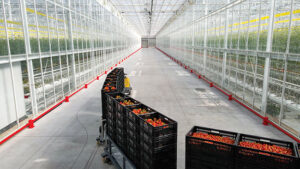
He also shares that in areas of sustainability, there are many benefits of greenhouse-grown produce and its ability to reduce food waste overall.
“In the greenhouse, the fruit defects are noticed early and pruned during crop maintenance, avoiding the wastage of valuable resources such as water and fertilizer and conserving energy overall,” he said.
Packaging materials have also been of focus; the company has invested in new material technologies such as washable labels that avoid contamination of the PET (polyethylene terephthalate) recycle stream. This has included increasing PCR (post-consumer recycled) levels in its PET containers, transitioning from nonrecyclable materials to recyclable materials on cucumber trays and different produce bags. The team also invested in compostable PLU’s for the organic produce.
OVERCOMING CHALLENGES
The last five years have been challenging for the produce industry, as growers navigated the increased demands and disease control.
“It has been difficult to navigate the ongoing efforts to irradiate the virus from our operations and the slow and methodical pace of the solutions-based mindset of our seed breeder partners, growers and crop care workers,” DiMenna said. “These challenges — and, most importantly, the patience of the retail, wholesale and food service trades — have required transparency in communications as growers work with the characteristics of the new, virus-resistant seed varieties.”
Additionally, the greenhouse industry has experienced a multitude of environmental factors such as fire, floods and low light levels.
“Operational costs, such as energy and labor are always being assessed,” DiMenna said. “Efficiently managing operational, energy and labor costs is the cornerstone of sustainable business growth and success.”
LOOKING AHEAD
DiMenna firmly believes that the greenhouse industry, alongside all controlled agriculture, is pivotal for the future. Red Sun Farms and its leadership team remains steadfast in its commitment to innovation, operational excellence and flavor enhancement; recognizing these as essential pillars for success.
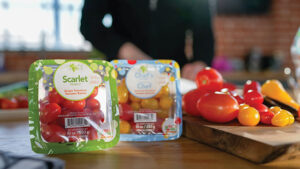
“Customers seek an outstanding culinary journey, one that captivates their senses and visual appeal,” DiMenna said. “Hence, we explore worldwide for novel tomato, cucumber and pepper varieties, aiming to gratify our customers with a complete sensory experience.”
Upon final reflection, he adds one more point — the greenhouse industry is poised for sustained growth and prosperity in the coming years. DiMenna urges the younger generations to explore the origins of their food and consider the promising opportunities within the greenhouse-grown market.








 Video Library
Video Library 

















